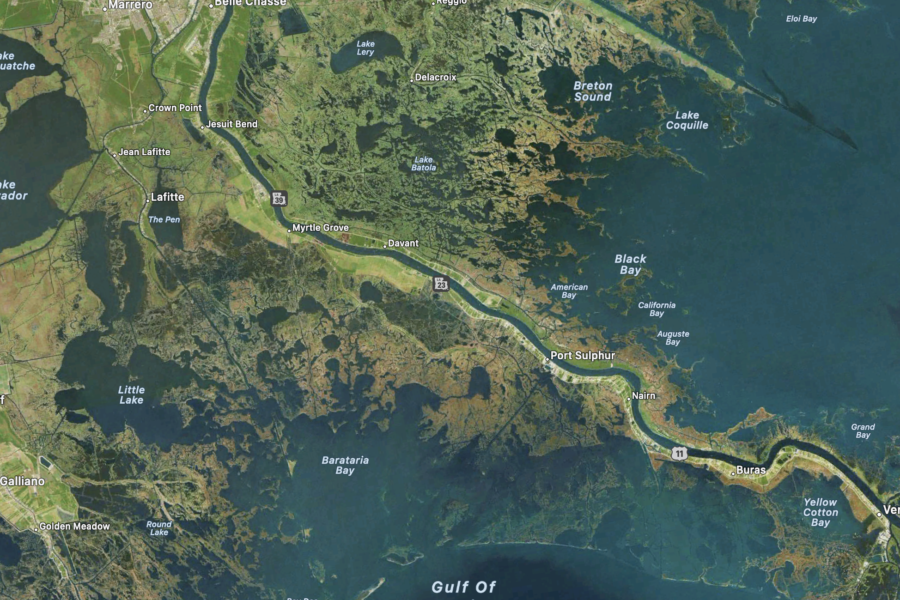My grandma used to say they could talk to each other across the river it was so narrow.
-Andrew (Kermit) Griffin
Today, much of the coastline area has been affected by both natural and unnatural causes. Those of us that live near the Breton Sound Basin are most affected by its changes. Historically the Breton Sound Basin would flood with great quantities of freshwater and sediment from the Mississippi River during the spring which caused saltwater from the Gulf of Mexico to be flushed out annually. This natural process that added fresh water and nourishment to the marshlands, and also helped combat saltwater intrusion, was entirely disrupted by the development of the flood protection levee system in the late 1930’s. Consequently, the saltwater in the basin is no longer flushed out every spring, causing salinity levels to drastically increase and further destabilization of the wetlands. The Breton Sound Basin is very important to us mostly because it serves as a buffer from hurricanes as well as a means to provide for families directly/indirectly. In a report from ‘The Economic Benefits of Fisheries, Wildlife and Boating Resources in the State of Louisiana’, “One of every 70 jobs in Louisiana can be attributed to commercial fisheries.”
According to ‘Historical and Projected Coastal Louisiana Land Changes: 1978-2050‘, Louisiana has lost approximately 1,829 square miles of land since the 1930’s. Currently, Louisiana has 30% of the total coastal marsh – and accounts for 90% of coastal marsh loss- in the lower 48 states.” (Dahl 2000, Field et al. 1991, USGS 2003). There are many contributing factors to the coastline’s rapid deterioration. Here we’ll list what we consider the 5 most impactful drivers of Louisiana’s coastal erosion.
- Nutrias (Myocastor coypus Molina) – First introduced to Louisiana in the 1930’s, the South American rodent has since wreaked havoc on the ecosystem. Because of their eating, digging, and rooting behaviors the nutria rat is primarily responsible for converting healthy marshlands into open water habitats.
- Levee Protection System – Before the construction of the Levee system in the late 1920s, the Mississippi River would flood annually depositing massive amounts of silt () into the marshland which would in turn build up the land and provide vital nutrients to the environment. In the late 1800s, the US Congress created the Mississippi River Commission which implemented a “levees only policy” that extended the levee system and sealed many of the river’s natural outlets. Because of this “levees only” policy, the surrounding marshlands no longer receive an overflow of silt from the river which has contributed to its deterioration.
- Unplugged Refinery Transport Canals – The oil refinery industry has dredged countless canals to transport their equipment to and from offshore oil rigs. The main difference between these artificial canals and natural canals is that they lack the winding and bending curves that you find in natural canals. Because these canals are straight they are more prone to erosion on both sides. Add illustration of artificial canal and natural depicting how the water moves. These artificial canals also serve as entry points for seawater to enter the marshland and raise saltwater levels which can cause havoc on the ecosystem. *see saltwater intrusion.
- MR-GO IntraOcean Canal – The Mississippi River- Gulf Outlet also known as the MR-GO or MRGO is a 76-mile channel constructed by the United States Army Corps of Engineers (coincidentally). The canal’s purpose was to create a shorter route between the Gulf of Mexico and New Orleans’ inner harbor Industrial Canal via the Intracoastal Waterway. In 2005, the MRGO channeled Hurricane Katrina’s devastating storm surge directly into the heart of New Orleans. Due to the tragic aftermath, the MRGO was forced to close and a permanent storm surge barrier was constructed to close the canal to all maritime shipping. Unfortunately, the channel was dredged through shallow bays, coastal marshes, and cypress swamps which negatively affected the overall environment.



